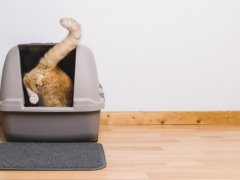
Tunatura / Shutterstock.com
If your cat is sneezing or maybe has itchy skin, your veterinarian may recommend starting an antihistamine. In this article, we’ll review 6 of the most common antihistamines, when they may be used, side effects to watch out for and links to learn more about each one.
Antihistamines for Cats

About Antihistamines for Cats

Just like us, cats can also suffer from allergy symptoms like sneezing, watery eyes, and itchy skin. Motortion Films / Shutterstock.com
Histamine is a chemical involved in the body’s inflammatory and allergy immune system response, especially in the respiratory passages and skin.
Histamine is stored within mast cells in tissues. In the bloodstream, a white blood cell called a basophil stores histamine.
During an inflammatory or allergy response, these cells will release histamine, which triggers a cascade of inflammatory changes like redness and swelling.
Antihistamines are medications that counteract histamine’s actions.
In general, antihistamines are used for cats with skin allergy symptoms like red, itchy skin, and hives. Sneezing suspected to be due to allergens may also respond to antihistamines.
There are three generations of antihistamines. First-generation antihistamines can cross the blood-brain barrier, leading to drowsiness and rarely, other side effects. First-generation antihistamines also last for a shorter time in the body, requiring more frequent dosing.
Second-generation antihistamines last longer in the body allowing them to be dosed less frequently. They do not cross the blood-brain barrier at typical doses, causing less drowsiness.
Third-generation antihistamines may be even more effective with fewer side effects like drowsiness.
Animals may respond differently to different antihistamines. If one is not successful for a treatment approach, another may be tried.
6 Antihistamines for Cats
There are several antihistamines. We will review the 6 most common. Most are over the counter with the final one, hydroxyzine, being prescription only.
1. Diphenhydramine

Benadryl (diphenhydramine) is one of the most recognized antihistamines. The Image Party / Shutterstock.com
We start with possibly the most recognizable antihistamine, diphenhydramine. The most common brand is Benadryl.
Diphenhydramine is a first generation antihistamine. It is most often used for itchy and allergic conditions including hives, contact allergy, and insect bite hypersensitivity.
It is also the antihistamine of choice for therapy associated with mast cell tumors. Made up of multiple cancerous mast cells, mast cell tumors can release large amounts of histamine especially if they are traumatized through blunt force, needle sampling at the veterinarian’s office to unmask their identity, and when removed surgically. Veterinarians commonly recommend Benadryl as part of therapy leading up to and surrounding mast cell tumor removal surgery.
Contrary to popular belief, first-generation antihistamines like diphenhydramine are less likely to be very effective in therapy for atopic dermatitis (skin reactions from environmental allergies).
While diphenhydramine has been used to assist with motion sickness in pets, it appears to have very poor efficacy in preventing motion sickness-induced vomiting in cats.
Benadryl may have drowsy effects in some pets, making it useful as a mild sedative.
The most common dose of Benadryl for pets is 2-4 milligrams per kilogram (mg/kg) every 12 hours. It can be given every 8 hours if needed.
Benadryl comes in 25mg tablets, making ½ to 1 whole tablet a common dose amount for most adult cats.
2. Chlorpheniramine

Chlorpheniramine is less commonly used, but another 1st generation antihistamine choice. Keith Homan / Shutterstock.com
Chlorpheniramine is a first-generation antihistamine with the brand name Chlor-Trimeton. As a first generation like Benadryl, it does have sedative effects. It has many of the same indications as well.
Since response to antihistamines is individualized with one patient responding to one form but not another, chlorpheniramine may be a consideration in pets where diphenhydramine is not effective.
There is some evidence that chlorpheniramine may provide limited benefit in cats with atopic skin syndrome (skin allergies), though efficacy is seen better with continuous use vs. only when symptoms arise.
Cats with chronic long-term rhinosinusitis (inflammation of the nasal passages and sinuses) may also see some benefit.
Chlorpheniramine is most often dosed at 2mg per cat every 8-12 hours. However, when it is used for treating long-term conditions and used every day, some cats may see benefits with once daily use.
Chlorpheniramine comes in a 4mg tablet size, making ½ tablet the most common dosing size for adult cats.
3. Loratidine

While not always a first choice, Claritin can be used if more common antihistamines are not effective. Keith Homan / Shutterstock.com
The common brand names for loratadine are Claritin and Alavert. Loratidine is a second-generation antihistamine and is considered free of the sedating effects Benadryl can be known for.
There is little in terms of studies or documentation on using loratadine in cats, but it may be recommended if other more commonly utilized antihistamines are not effective.
Dosing for cats is 0.5mg/kg. The 5mg tablet size makes 2.5-5mg per cat the most common dosing size. Loratidine is given only once a day.
4. Fexofenadine

Allegra is another non-drowsy 2nd generation antihistamine to consider if a cat doesn’t respond to another choice. AllesandraRC / Shutterstock.com
Better known as Allegra, fexofenadine is another second-generation antihistamine. There is little indication to use fexofenadine over any other second-generation antihistamine. But in cats that don’t respond to cetirizine or loratadine, fexofenadine is another option.
The dosage range for fexofenadine is wider with recommendations of 15 to 30mg per cat every 12 to 24 hours. Regular Allegra tablets come in 60mg, making ¼ to ½ tablet most common to give. The disintegrating tablets come in 30mg so with this form, ½ to a whole tablet can be used.
5. Cetirizine

Zyrtec is the most commonly recommended 2nd generation antihistamine for cats, showing some benefit with skin allergies. jadimages / Shutterstock.com
Cetirizine, more commonly known by the brand name Zyrtec, is our next second-generation antihistamine.
Cetirizine is commonly prescribed for signs of respiratory allergies like sneezing and clear discharge from the eyes and nose. It may also be utilized for allergic responses causing hives and for insect bites.
More in cats compared to dogs, cetirizine appears to help with atopic dermatitis, also known as allergic skin disease. A little less than 50% of cats may see a response where their itching is lessened.
The most evidence-based dosing for cetirizine where about 40% of cats had controlled signs of itching is 5 mg per cat given every 24 hours.
6. Hydroxyzine

Due to additional effects not seen with other antihistamines, hydroxyzine requires a prescription. luchschenF / Shutterstock.com
Hydroxyzine, known by the brands Atarax and Vistaril, is a first-generation antihistamine. It’s the only one of our list that’s available only by prescription.
Hydroxyzine is a unique antihistamine in that it has some additional effects due to a chemical structure called a piperazine ring. Medications containing this structure can have effects on nausea and anxiety. Hydroxyzine is also suspected to have activity on serotonin, lending to its varying sedative, tranquilizing, and anxiolytic (anti-anxiety) effects.
These expanded effects compared to other antihistamines are the reasons for its prescription-only status.
In pets, its use for anxiolytic, tranquilizing, and sedative effects are not well established. It’s not often used for these effects since there are other medications with far more evidence of use.
For allergy-related signs, hydroxyzine has fallen out of favor, though some veterinarians may still prescribe it. Hydroxyzine is rapidly converted by the body into cetirizine. Since cetirizine (Zyrtec) itself is widely available over the counter, may be more effective, does not have sedative effects and carries a lower risk of other unanticipated side effects, it has widely replaced hydroxyzine.
Since hydroxyzine is a prescription medication, it’s best to check with your vet about dosing and frequency and if it’s appropriate for your cat.
How to Administer Antihistamines to Cats
Most antihistamines come in a simple tablet form.
For more information on how to administer pills to cats, see our articles on the best cat foods to hide pills in and step by step guide for giving a pill to your cat.
For the liquid forms of antihistamines, the concentrations they come in would require giving a cat anywhere from 2 ½ ml to 5 ml or more per dose. This amount would be fairly difficult to administer to most cats without losing at least part of what is administered.
Some liquid formulations also contain propylene glycol, which is toxic to cats.
A few of the antihistamines come in an oral disintegrating tablet form. These include:
- Fexofenadine (Allegra)
- Loratadine (Claritin)
- Cetirizine (Zyrtec)
Oral disintegrating tablets can be placed on the tongue or at least just popped in the mouth, avoiding the need for full pilling if doing that is difficult for your cat.
Side Effects of Antihistamines for Cats
Just as the therapeutic effects of antihistamines can vary among individuals, so can the side effects. But here are some to look out for.
An expected side effect for any 1st generation antihistamine can be some degree of sedation. Second-generation antihistamines have far less sedating effects. Sedating effects may be more likely to occur with higher doses.
First-generation antihistamines also have side effects called anticholinergic effects. These can include:
- Dry mouth
- Urine retention
- Stool retention
- Dry eye
- High heart rate
Other adverse effects that may be seen uncommonly with any antihistamine include:
- Paradoxical excitement
- Vomiting
- Reduced appetite
- Tremors
- Seizures (very rarely)
Overdose and Emergencies

Pseudoephedrine, which is a decongestant found in the “D” forms of antihistamines is toxic to pets and should never be used. RYO Alexandre / Shutterstock.com
The effects of an overdose of an antihistamine depend on what generation it’s from and how high the overdose is.
Overdoses with 1st generation antihistamines are more likely to cause sedation initially. With higher overdoses, more concerning effects like tremors, difficulty with balance and walking, seizures, coma, and even cardiac arrest can occur.
With 2nd generation antihistamines, significant side effects are less likely to occur. With higher overdoses, similar side effects to those seen with 1st generation antihistamines become a risk. While 2nd generation antihistamines are much less likely to have CNS side effects, high overdoses can still lead to those effects.
As mentioned earlier, some liquid formulations of antihistamines contain propylene glycol, which is toxic to cats. If you elect to use a liquid form, always check for this ingredient and avoid using that product.
One of the most significant emergencies can result from a pet taking any form of an antihistamine containing pseudoephedrine. Pseudoephedrine is added as a decongestant, leading to this being called the decongestant or “D” form of the medication. Brand name examples include Benadryl-D, Claritin-D, and Zyrtec-D.
Pseudoephedrine stimulates the cardiovascular and nervous systems. Side effects of pseudoephedrine ingestion in cats can include:
- Restlessness
- Agitation
- High Blood Pressure
- Elevated Body Temperature
- Tremors
- Dilated Pupils
If you are concerned your cat may have received an overdose of an antihistamine or ingested an antihistamine containing propylene glycol or pseudoephedrine, make sure to immediately contact one of the following:
- Your veterinarian
- ASPCA Animal Poison Control Center (1-888-426-4435)
- Pet Poison Helpline (1-855-764-7661)
Potential Drug Interactions With Antihistamines
There are a couple of medications that may have interactions with antihistamines. Unless indicated, this does not necessarily mean these cannot be used together but caution should be exercised. Use together should be considered in light of risks of potential side effects versus potential benefits.
If you have additional questions, make sure to check with your veterinarian.
This list is not exhaustive but represents the more common medications used in cats. Always check with your vet first before starting any new medication.
- Central nervous system (CNS) depressant medications (mirtazapine, trazodone): additional CNS depression may occur, especially with 1st generation antihistamines.
- Opioids (buprenorphine, tramadol): additional CNS depressant effects and anticholinergic effects.
- Prokinetic agents (cisapride): 1st generation antihistamines with more significant anticholinergic effects may interfere with the therapeutic effects of medications like cisapride.
- Tricyclic antidepressants (amitriptyline, clomipramine): additive CNS depression and anticholinergic effects may occur.
- Benzodiazepines (alprazolam, diazepam): additional CNS depression may occur
How to Store Antihistamines
Antihistamine tablets and liquid should be stored at room temperature. The liquid formulations should never be frozen. If the disintegrating tablet forms are broken or split, it’s important to keep them away from any moisture exposure.
Antihistamines for Cats
Are antihistamines safe for cats?
Yes, antihistamines are considered a safe medication for cat allergies at acceptable doses. It is important to avoid any combination products with pseudoephedrine, which will have a “D” designation (Zyrtec-D, Benadryl-D). Also make sure to avoid any liquid forms containing propylene glycol as an ingredient.
Any individual may have an adverse response to an antihistamine, just like any medication. The sedation effects, especially from 1st generation antihistamines, may also vary. If you have concerns after your cat takes an antihistamine, touch base with your veterinarian.
What if I miss a dose of an antihistamine?
If your cat is getting an antihistamine every 12 hours and it has been 3-4 hours or less since the missed dose, give the next dose ASAP. If it has been more than 4 hours, wait until the next dose is due.
If your cat is getting an antihistamine every 24 hours and it has been 6-8 hours or less since the missed dose, give the next dose ASAP. If it has been more than 8-12 hours, wait until the next dose is due.
Make sure to clarify further with your vet if needed.
How long does it take for antihistamines to work in cats?
After giving an oral antihistamine, it may take up to 4-6 hours to reach peak effect. If an acute allergy crisis/allergic reaction is occurring seeking emergency care is best where use of injectable medications can have a faster effect.
How long can cats take antihistamines?
There is little data available on long-term use. However, clinical research and experience does suggest that antihistamines will be most effective for preventing flare-ups of chronic skin allergy conditions in cats when used regularly long-term (as opposed to giving it only when a flare-up is seen).
What time of day should cats take antihistamines?
This depends on whether the antihistamine is given once or twice a day. Giving it to your cat at the time of a morning or evening meal may be the most convenient.
-
A Budde, J., M McCluskey, D., & Plumb, D. (2023). Plumb’s Veterinary Drug Guide (10th ed.) [Phone App]. Wiley Blackwell.
-
American Animal Hospital Assocition (AAHA). (2023, October 8). Table 8: Oral antihistamine doses for cats. American Animal Hospital Association.
-
Weir, M., Hunter, T., & Ward, E. (n.d.-a). Allergies in Cats. VCA Animal Hospitals.
-
Khuly, P. (2010, January 29). Why I Love Zyrtec for Cats. petMD by Chewy.
-
Thompson, L. (2013, December). Feline Dermatology: Cats Are Not Small Dogs. Today’s Veterinary Practice.
-
ASPCA. (n.d.). Pseudoephedrine Toxicity in Pets. ASPCApro.
-
Hannemann, K., & Woodcock, S. (2024, January 25). Hydroxyzine vs. Benadryl: 7 Differences Between These Antihistamines. GoodRx.







